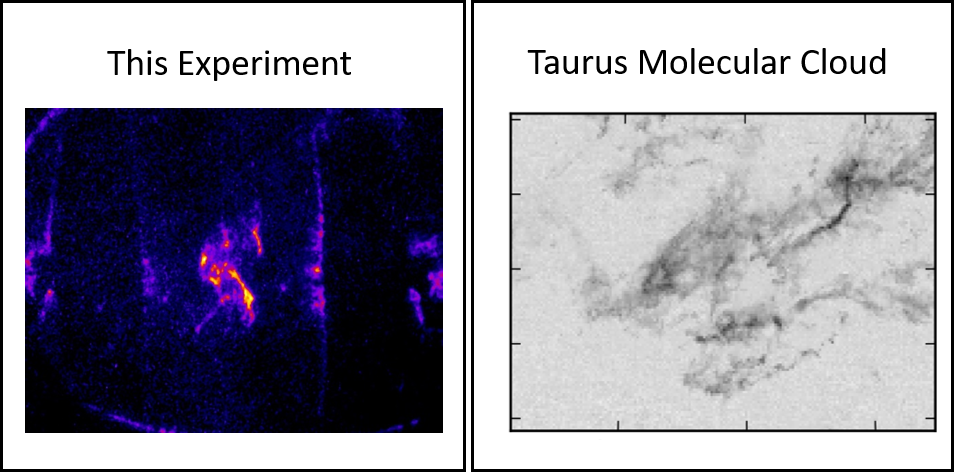.jpg) Turbulence is a familiar term to most of us – from the seemingly random turbulence that aeroplanes encounter, to the way milk swirls as it mixes into your tea. However it remains that, despite decades of effort, astrophysical turbulence in particular has so far been impossible to predict. While many observations have been made, and there has been progress in the past to simulate or calculate mathematically turbulence's seemingly random whirls and cascades, the phenomenon remains largely mystery.
Turbulence is a familiar term to most of us – from the seemingly random turbulence that aeroplanes encounter, to the way milk swirls as it mixes into your tea. However it remains that, despite decades of effort, astrophysical turbulence in particular has so far been impossible to predict. While many observations have been made, and there has been progress in the past to simulate or calculate mathematically turbulence's seemingly random whirls and cascades, the phenomenon remains largely mystery.
The way terrestrial turbulence works is much like a domino effect, where larger turbulence triggers smaller turbulence, and the smaller turbulence triggers even smaller turbulence, and so on and so forth. This phenomenon is known to physicists as “turbulent cascade". However, extra-terrestrial turbulence has a few added factors that make it an entirely different kettle of fish.
For example, observations of the turbulence in the Orion B and Perseus molecular clouds show large deviations from those predicted for turbulence, yet attempting to improve predictions through observation may take millions of years, as these are the timescales that astronomical molecular turbulence patterns move in.
Part of the reason why astronomical molecular turbulence is so hard to predict, is the creation of small shock waves during the process. So, in order to simulate turbulence complete with shockwaves, a team from the University of Oxford led by Gianluca Gregori in collaboration with the Central Laser Facility (CLF) recreated it right in the CLF's Vulcan lab – effectively creating miniature astronomical turbulence on a tiny, observable scale.
Prof. Tom White, lead author of the paper, explains: “We can use laboratory experiments to improve our understanding of physical processes and apply these results to the processes throughout the Universe. Just like putting a car in a wind tunnel to predict how it'll behave out on the road; we perform experiments in the laboratory to predict how many astrophysics situations evolve."
The laboratory, known as Vulcan Target Area West, has 8 high power laser beams with a high degree of flexibility in terms of how they can be arranged (i.e. beam layout, energies, laser colour, pulse length) making it a great instrument for lab astro-physics. In this experiment, with the help of link scientists Rob Clarke, Rob Heathcote, Margaret Notley and Matt Selwood, and plasma physics experts Tony Bell, Robbie Scott and Bob Bingham, the team used 2 clusters of 3 beams in a colliding geometry to drive two counter-propagating jets of plasma.
 These supersonic plasma jets travelled at speeds of up to Mach 6, which is more than 7,000 miles per hour. By passing the jets through a pair grids and colliding them, the team was able to produce a region of supersonic turbulence and observe the resulting shockwaves. They were able to watch the turbulence transition from low-velocity turbulence to the sort of high-velocity turbulence seen in star-forming nebulae – the first time this has been studied in the laboratory.
These supersonic plasma jets travelled at speeds of up to Mach 6, which is more than 7,000 miles per hour. By passing the jets through a pair grids and colliding them, the team was able to produce a region of supersonic turbulence and observe the resulting shockwaves. They were able to watch the turbulence transition from low-velocity turbulence to the sort of high-velocity turbulence seen in star-forming nebulae – the first time this has been studied in the laboratory.
The team hope that the work will open a new avenue in the study of supersonic turbulence that could be used alongside existing computational and observational techniques. They plan to extend their work to include a magnetic field component to their experiments. This is necessary because powerful magnetic fields are known to be present in star-forming clouds, which scientists believe also affects the behavior of turbulence.
To read the blog post by lead author Tom White, go here.
To read the Nature Communications paper, go here.
Image 1:
Pixabay image. Ink dropped into water showing turbulence.
Image 2:
Supersonic plasma generated in the experiment (left) and CO integrated intensity map of the Taurus Molecular Cloud (right). Notice the formation of thin features in both, a characteristic of shock-wave formation and supersonic turbulence. The image on the right is reproduced from Brunt, C. M. "The density variance–Mach number relation in the Taurus molecular cloud." Astronomy & Astrophysics 513 (2010): A67.
